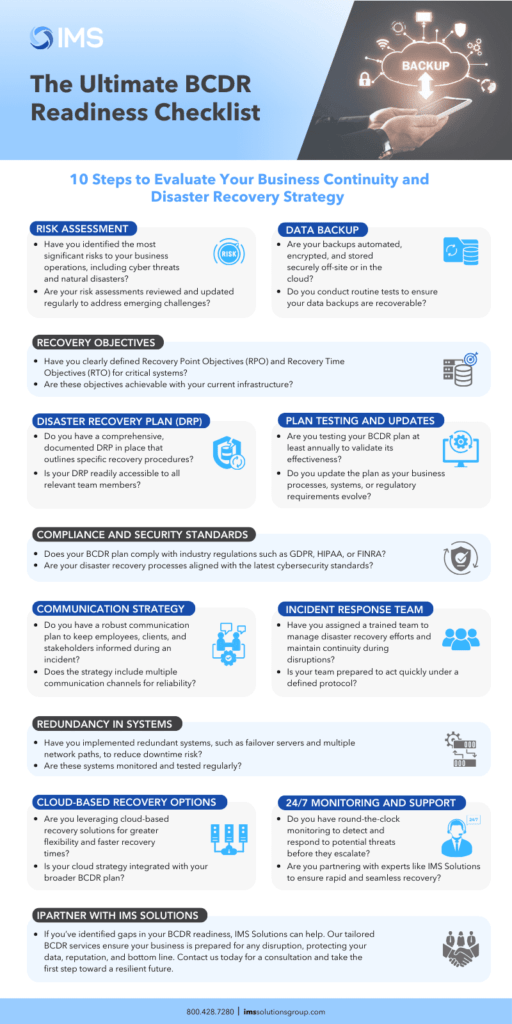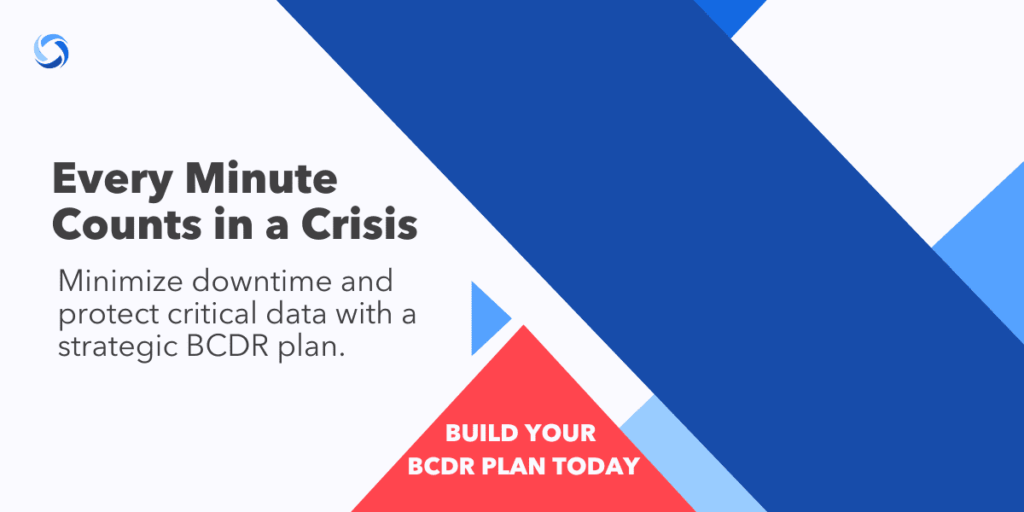Unexpected disruptions can bring businesses to a standstill, costing time, money, and trust. Cyberattacks, hardware failures, natural disasters, or human errors can disrupt your operations in an instant, with impacts that escalate faster than you might expect. Without a clear plan in place, you risk prolonged downtime, significant financial losses, and damaged customer trust—consequences that can take months or even years to repair.
A 2024 study by Gartner revealed that 76% of businesses experienced at least one major outage in the past 12 months, with downtime averaging over 90 minutes per incident. This doesn’t just disrupt operations—it directly affects revenue, employee productivity, and customer satisfaction. If you’re not prepared, recovering from even a short-term disruption can feel overwhelming and chaotic.
A business continuity and disaster recovery (BCDR) strategy ensures your business stays prepared for disruptions while minimizing the impact on operations. But what does BCDR actually mean, and why is it critical for businesses like yours to make it a priority in 2025?

What is BCDR?
A Business Continuity and Disaster Recovery (BCDR) strategy combines two critical approaches designed to protect and maintain your business operations during and after disruptions:
- Business Continuity (BC) ensures that your business can continue its essential operations during a disruption, whether it’s a cyberattack, power failure, or other unexpected events. This involves maintaining key functions, such as remote work access or critical services, to minimize operational interruptions.
- Disaster Recovery (DR) focuses on quickly restoring your critical systems and data after an incident. Once the immediate impact is addressed, disaster recovery ensures that systems are fully restored, and data is recovered, allowing your business to return to normal operations.
Together, these two elements form a comprehensive safety net. For instance, during a ransomware attack, continuity allows employees to work remotely and access backup systems, while recovery focuses on restoring compromised servers and recovering lost data. By integrating both, you safeguard not only your business’s immediate operations but also its long-term resilience.
Why Businesses Need a Strategic BCDR Plan
Here’s why a BCDR plan is critical for businesses heading into 2025:
1. Minimizing Downtime
Downtime directly impacts revenue, productivity, and customer satisfaction. For example, a server failure at a manufacturing plant could halt production for hours, delaying orders and frustrating customers. According to a 2024 Uptime Institute report, the average outage costs businesses over $100,000 per hour. A BCDR strategy ensures redundant systems are ready to step in, keeping operations running while IT teams address the issue. The faster you can respond, the less disruption your business will face.
2. Protecting Against Data Loss
Your business relies on critical data—customer records, financial documents, and operational files. Losing access to this data, even temporarily, can disrupt workflows and erode trust. A 2024 Cybersecurity Ventures study predicts that ransomware attacks occur every two seconds globally by 2031, putting businesses at constant risk. A BCDR plan prioritizes secure, automated backups that ensure your data remains accessible and recoverable, no matter what happens.
3. Safeguarding Reputation
Your customers expect reliability. If your business fails to deliver during a disruption, it doesn’t just impact revenue—it can damage your reputation for good. For instance, an e-commerce company experiencing prolonged outages may lose customers to competitors who can fulfill orders seamlessly. A swift, well-managed recovery demonstrates professionalism and reassures customers that their trust in your business is well-placed.
4. Mitigating Financial Loss
The financial impact of disruptions goes beyond lost revenue. Businesses face recovery expenses, regulatory penalties, and the cost of winning back lost customers. According to the IBM Cost of a Data Breach Report 2024, the average data breach costs businesses $4.5 million. A strategic BCDR plan reduces these risks by minimizing downtime, streamlining recovery efforts, and preventing costly long-term outages.
5. Ensuring Compliance
Industries like finance, healthcare, and legal services face strict regulations for data protection and continuity planning. Frameworks such as HIPAA, GDPR, and FINRA require businesses to have measures in place for recovering data and maintaining operations. Non-compliance can lead to fines, legal action, or even loss of business licenses. A BCDR plan aligns your processes with regulatory requirements, ensuring your business remains compliant while safeguarding critical data.

6. Defending Against Cybersecurity Threats
Cyberattacks are growing more frequent and sophisticated, from ransomware and phishing to Distributed Denial of Service (DDoS) attacks. Without a recovery plan, businesses can struggle to resume operations and restore systems, losing valuable time and data in the process. A BCDR strategy builds layers of protection such as automated backups, redundancy, and incident response protocols to help your business recover quickly and minimize the impact of cyber threats.
7. Supporting Remote Work and Distributed Teams
With hybrid and remote work environments becoming the norm, employees rely on continuous access to systems, networks, and data. A disruption, like a server crash or network outage, can disconnect teams and halt productivity. A BCDR plan prioritizes cloud-based solutions and redundant systems, ensuring your employees can stay connected and productive from anywhere, even during disruptions.
8. Preparing for Natural Disasters
Natural disasters like floods, hurricanes, and wildfires can devastate businesses, particularly those with limited recovery plans. According to FEMA, 40% of small businesses fail to reopen after a natural disaster. Without offsite backups or cloud-based solutions, regaining operations can be nearly impossible. A BCDR plan ensures your data and systems are protected, enabling you to maintain operations even if physical offices become inaccessible.
9. Enhancing Customer Confidence
Your customers depend on you to deliver, regardless of challenges. A visible, well-executed BCDR plan reassures clients that you’re prepared to handle disruptions without compromising service quality. Whether it’s a brief outage or a larger-scale incident, demonstrating resilience builds confidence and strengthens relationships with customers who value reliability.
10. Fostering Strategic Resilience
Resilience goes beyond surviving disruptions. A BCDR plan helps your business anticipate risks, adapt to challenges, and recover faster. For example, businesses that weathered the pandemic successfully had continuity plans that allowed them to pivot operations and maintain productivity. By prioritizing BCDR, you’re not just safeguarding today—you’re building a foundation for future growth and success.
Key Components of an Effective BCDR Strategy
Building a reliable BCDR plan requires careful planning and execution. Here are the key components to include:
- Risk Assessment and Business Impact Analysis
Identify potential risks, such as cyberattacks, power outages, or natural disasters, and evaluate how they could disrupt your operations. This helps you understand what’s at stake and where to focus resources at, so you’re prepared for the most critical situations. - Data Backup and Storage Solutions
Regular, automated data backups are vital for ensuring your business can recover from disruptions. Implement secure storage solutions, both on-site and cloud-based, to ensure your critical data remains protected and easily accessible. - Recovery Point Objectives (RPO) and Recovery Time Objectives (RTO)
RPO defines the amount of data your business can afford to lose before it impacts operations. RTO establishes how quickly you need to restore operations to minimize downtime, so your business can return to normal as fast as possible. - Disaster Recovery Plan (DRP) Documentation
Document your recovery process clearly, outlining each step for restoring systems, accessing backups, and resuming operations. This ensures your team knows exactly what to do and can respond quickly and efficiently during an emergency. - Regular Testing and Updating of the Plan
A BCDR plan is only effective if it’s regularly tested. Perform tabletop exercises or live drills and update your plan to account for new risks or changes in technology to keep it relevant and actionable.

- Redundancy in Systems and Infrastructure
Incorporate redundancy into your critical systems, such as backup servers and cloud solutions, to minimize the risk of prolonged downtime. This ensures your operations can continue even if one system fails. - Incident Response Team and Protocols
Designate a team responsible for executing the plan during a crisis, with clear roles and responsibilities. This ensures your team is prepared to act quickly, following established protocols to minimize disruption. - Communication Plan for Stakeholders
Develop a communication plan for informing employees, clients, vendors, and partners during disruptions. Transparent, timely communication helps maintain trust and prevents confusion during challenging times. - Cloud-Based Recovery Options
Cloud-based recovery options offer flexibility and scalability, allowing your business to access systems, data, and applications from anywhere. This reduces reliance on physical infrastructure and enhances your ability to recover quickly after a disruption. - Integration with Compliance and Security Standards
Ensure your BCDR plan aligns with relevant regulatory frameworks and security standards. This helps you meet industry requirements and ensures that sensitive data remains secure during recovery efforts.
Securing Your Business Future with IMS Solutions
IMS understands that unplanned disruptions don’t wait for the “right time.” Our Business Continuity and Disaster Recovery (BCDR) solutions are built to ensure your business keeps moving—no matter the challenge. With automated, secure backups and rapid recovery options, we help you minimize downtime, protect critical data, and maintain customer trust when it matters most. Whether it’s a cyberattack, hardware failure, or a natural disaster, you’ll have the confidence of knowing your operations can recover quickly and effectively.
We work alongside you to design a tailored BCDR strategy that fits your business needs and priorities. From risk assessment to regular testing, IMS ensures every step of your plan is clear, actionable, and reliable. With our support, you’re not just preparing for disruptions, you’re building resilience that keeps your business strong and your customers confident.
Ready to safeguard your business? Contact IMS today to create a BCDR plan that ensures you’re prepared for whatever comes next.




